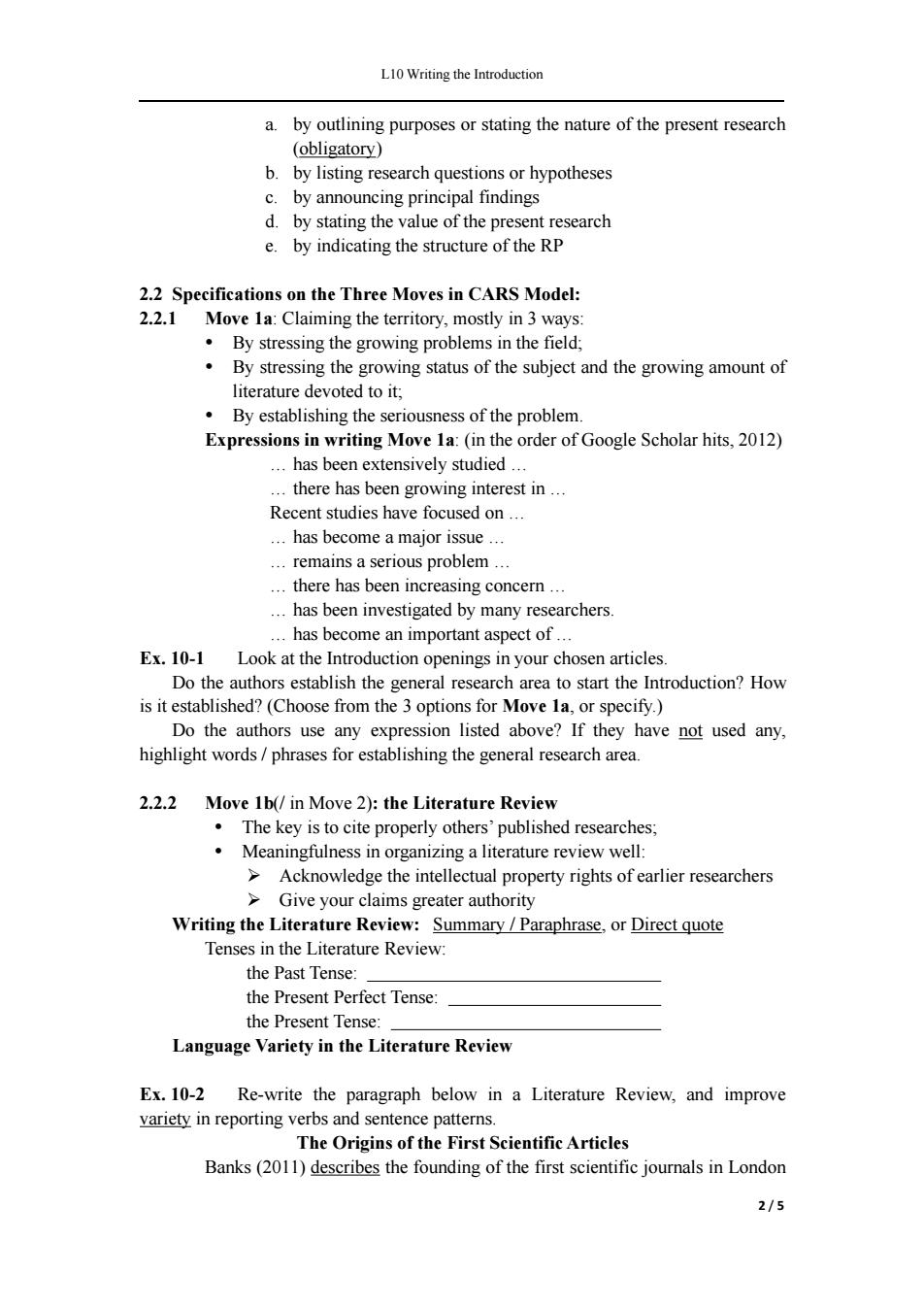正在加载图片...

L10 Writing the Introduction a.by outlining purposes or stating the nature of the present research (obligatory) b.by listing research questions or hypotheses c.by announcing principal findings d.by stating the value of the present research e.by indicating the structure of the RP 2.2 Specifications on the Three Moves in CARS Model: 2.2.1 Move 1a:Claiming the territory,mostly in 3 ways: By stressing the growing problems in the field; By stressing the growing status of the subject and the growing amount of literature devoted to it; By establishing the seriousness of the problem Expressions in writing Move 1a:(in the order of Google Scholar hits,2012) ..has been extensively studied... ..there has been growing interest in... Recent studies have focused on... ..has become a major issue... ..remains a serious problem... ..there has been increasing concern... ..has been investigated by many researchers. ..has become an important aspect of... Ex.10-1 Look at the Introduction openings in your chosen articles. Do the authors establish the general research area to start the Introduction?How is it established?(Choose from the 3 options for Move 1a,or specify.) Do the authors use any expression listed above?If they have not used any, highlight words/phrases for establishing the general research area. 2.2.2 Move 1b(/in Move 2):the Literature Review The key is to cite properly others'published researches; Meaningfulness in organizing a literature review well: >Acknowledge the intellectual property rights of earlier researchers >Give your claims greater authority Writing the Literature Review:Summary Paraphrase,or Direct quote Tenses in the Literature Review: the Past Tense: the Present Perfect Tense: the Present Tense: Language Variety in the Literature Review Ex.10-2 Re-write the paragraph below in a Literature Review,and improve variety in reporting verbs and sentence patterns. The Origins of the First Scientific Articles Banks(2011)describes the founding of the first scientific journals in London 2/5L10 Writing the Introduction 2 / 5 a. by outlining purposes or stating the nature of the present research (obligatory) b. by listing research questions or hypotheses c. by announcing principal findings d. by stating the value of the present research e. by indicating the structure of the RP 2.2 Specifications on the Three Moves in CARS Model: 2.2.1 Move 1a: Claiming the territory, mostly in 3 ways: By stressing the growing problems in the field; By stressing the growing status of the subject and the growing amount of literature devoted to it; By establishing the seriousness of the problem. Expressions in writing Move 1a: (in the order of Google Scholar hits, 2012) … has been extensively studied … … there has been growing interest in … Recent studies have focused on … … has become a major issue … … remains a serious problem … … there has been increasing concern … … has been investigated by many researchers. … has become an important aspect of … Ex. 10-1 Look at the Introduction openings in your chosen articles. Do the authors establish the general research area to start the Introduction? How is it established? (Choose from the 3 options for Move 1a, or specify.) Do the authors use any expression listed above? If they have not used any, highlight words / phrases for establishing the general research area. 2.2.2 Move 1b(/ in Move 2): the Literature Review The key is to cite properly others’ published researches; Meaningfulness in organizing a literature review well: Acknowledge the intellectual property rights of earlier researchers Give your claims greater authority Writing the Literature Review: Summary / Paraphrase, or Direct quote Tenses in the Literature Review: the Past Tense: the Present Perfect Tense: the Present Tense: Language Variety in the Literature Review Ex. 10-2 Re-write the paragraph below in a Literature Review, and improve variety in reporting verbs and sentence patterns. The Origins of the First Scientific Articles Banks (2011) describes the founding of the first scientific journals in London